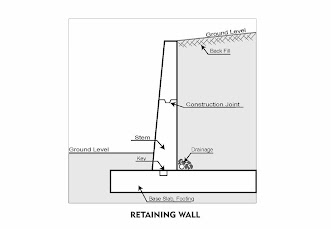What Is Spalling Of Concrete ?
Spalling of concrete refers to the chipping, cracking, or flaking off of the surface layer of concrete, typically caused by the deterioration of the material beneath the surface. It results in the exposure of the aggregate (gravel or sand) inside the concrete, leaving behind an uneven and unsightly surface. Spalling can also lead to structural damage if not addressed.
Spalling is caused by certain chemical reactions inside the concrete which lead to the formation of foreign products which are of high volume. These new products due to lack of space inside the concrete will increase the internal pressure. As a result, cracks are formed to release this pressure outside.
 |
Civil Insta
|
Causes Of Spalling Of Concrete
- Corrosion of Embedded Metals
- Inadequate Cover
- Freeze-Thaw Cycles
- High Temperature
- Alkali Aggregate Reactions
- Improper Curing
- Improper Water Content
- Sulphate Attack
- Chloride Attack
- Rough Finishes
1. Corrosion Of Embedded Metals
As described earlier, steel uses for the reinforcement, so the corrosion of the steel and other embedded material cause the deterioration of concrete. When steel rust the resultant corrosion occupies a large volume than the steel.
2. Inadequate Cover
Inadequate cover will increase the vulnerability of the reinforcement to the environment. Even the slightest crack on the surface will expose the reinforcement. When steel comes in contact with water and air, it corrodes. The products of the corrosion have high volume than that of steel causing high internal pressure and thereby causing spalling.
3. Freeze-Thaw Cycles:
In areas with cold climates, water trapped within the concrete can freeze and expand when temperatures drop. When this happens repeatedly, the concrete surface can spall off. This is a typical problem in regions subject to freezing and thawing conditions
4. High Temperature
Explosive spalling may occur during fire or when concrete is exposed to high temperature which causes high pore pressure developed by the oversaturation. High strength concrete is more vulnerable to failure under high temperature than that of normal strength concrete due to the increased brittleness.
5. Alkali Aggregation Reactions
When the alkali in the cement reacts with silica in the aggregate in the presence of water, it will from the alkali silica gel which is higher in volume than the conventional products of hydration.
6. Improper Curing
If concrete is not cured properly, it may not achieve the necessary strength and durability. Lack of proper curing can lead to surface defects, including spalling.
7. Improper Water Content
Low water content will reduce the workability and make it hard for compaction. This may lead to the formation of unintended air pockets which may later pave a way for crack formation. High water cement ratio will reduce the strength of the concrete thus making it more vulnerable to micro cracks and thereby spalling.
8. Sulphate Attack
It is caused by rich cement or the sulphate present in the atmosphere. The decomposition of the products of the hydration reaction leads to reduction in the strength of the concrete and in doing so causes spalling.
9. Chloride Attack
This occur in structures exposed to sea water. Chloride attack will directly cause corrosion to the steel reinforcement inducing the spalling concrete.
10. Rough Finishes
A rough finished surface structure tends to accumulate more water on the surface than a smooth surface finished structure. The rough finished structure will increase the seepage of water and may encourage spalling.
Repairing Concrete Spalling:
1. Surface Preparation:
The affected area must be cleaned and prepared by removing any loose concrete, debris, or rust. Typically, a wire brush, chipping hammer, or pressure washer is used for this process.
2. Remove Corroded Rebar:
If the underlying reinforcement is corroded, it must be cleaned or replaced. Corroded rebar should be sandblasted or wire brushed to remove rust, and any severely corroded sections may need to be replaced.
3. Apply a Bonding Agent:
A bonding agent is often applied to the clean surface to ensure that the repair material properly adheres to the existing concrete.
4. Patch the Spalled Area:
The spalled areas can be repaired using a concrete patching compound or a repair mortar. These materials are applied to the affected areas and smoothed out to match the surrounding surface. It's crucial to use the right type of repair material to match the original concrete's strength and durability.
5. Curing the Repair:
After the patching material is applied, it should be properly cured to allow it to set and harden. Curing helps the repair material achieve maximum strength and bond effectively with the existing concrete.
6. Surface Finishing:
Once the repair material has cured, the surface may need to be ground or polished to blend in with the surrounding concrete. If necessary, a sealant or protective coating can be applied to reduce the risk of moisture infiltration and further damage.
7. Reinforcement with Carbon Fiber:
In cases of significant structural damage, additional reinforcement using carbon fiber strips or mesh may be required to provide extra strength to the repaired area.
8. Prevention:To prevent future spalling, it’s essential to address the root cause. This could include ensuring proper drainage, applying a concrete sealant, using corrosion-resistant reinforcement, and improving the quality of the concrete during the initial construction phase.
















